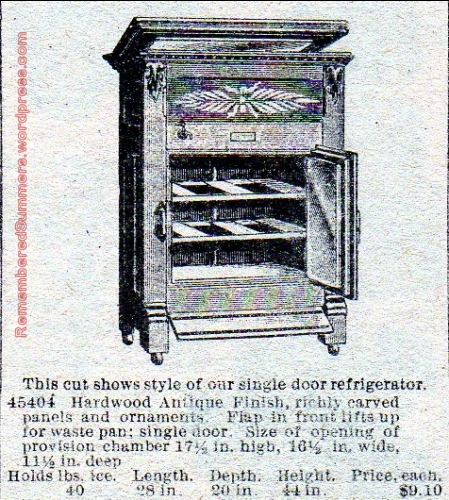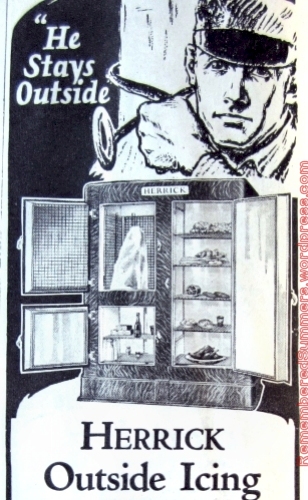In the 1950s, my grandmother used the words “Icebox” and “Refrigerator” interchangeably. Married in the 1890s, she’d had an icebox for several decades longer than she’d had an electric refrigerator in her kitchen. My parents also said “the icebox” fairly often. My husband, whose parents grew up on small farms in Texas, claims he never heard anyone say “refrigerator” until he met me. Some of the upper-class girls in his high school in the 1960s said “fridge.” He thought it was short for Frigidaire, a brand name electric refrigerator.
I was surprised to see that the Montgomery Ward catalog called this icebox a refrigerator in 1894; to my folks, a “refrigerator” was an electric appliance.
The Icebox
As I recall, from seeing one at a rural cabin, the icebox usually had thick wooden doors – for insulation. In the basic model there were two compartments, lined with rust-proof metal; the bottom one held the food and the top one held a block of ice – as much as 40 lbs. Being a solid block, rather than cubes, it took several days to melt completely – I have no idea how the housewife dealt with all that meltwater. It collected in a pan inconveniently located on the floor, behind that hinged flap at the bottom, and she had get down on her knees and empty it daily to be sure it never overflowed.
When I asked my Grandma about “icebox” and “refrigerator,” she explained that, if you had an icebox, the iceman brought a fresh block of ice to your house on a regular basis. What she recalled was the mess.
The Iceman
The Iceman was supposed to come to your back door (if you had one) and take the shortest route to the kitchen – or back porch, if that was where the icebox was. He carried the block of ice with ice tongs, and he usually had a pad of folded burlap sacking on his shoulder, so he could rest the ice there; the sacking was supposed to absorb the drips from the melting ice – a real problem with summer deliveries. But sometimes a lazy iceman came to the front door, carried the ice at his side instead of on his shoulder, and left a trail of water all the way through the house – and then walked through it on his way back to the delivery truck! That’s what stuck in Grandma’s memory. It must have taken a determined iceman to do that in her house, because her family, the Lipps, owned the Ice Company!
The Iceman Cometh
If you’re interested in Eugene O’Neill’s play, The Iceman Cometh, I do have a few things to say about it – but, since I don’t want to encourage plagiarism, I’ll say them in as casual and indirect a format as I can. (The old adage applies: If you steal from one writer, that’s plagiarism. If you steal from many writers, that’s research.)
The title of the play is a reference to an off-color joke which would probably have been familiar to most of O’Neill’s audience. It begins, “A husband comes home from work early on a hot day. He hollers upstairs to his wife, ‘Has the iceman come yet?’ “. . .
When reading or staging a play by O’Neill, it’s very important to pay attention to his references to poetry, songs, jokes, catch-phrases, and popular culture in general. If O’Neill mentions a popular song, it’s usually worth looking up all the lyrics. With the internet, there’s no reason not to! In Ah, Wilderness! For example, there are many such references. An audience of O’Neill’s contemporaries probably got them all; now we have to have program notes written by a dramaturg.
Popular Culture and the Iceman
In The Iceman Cometh the central character, Hickey, is a salesman. Telling jokes was part of the salesman’s stock in trade. Jokes about traveling salesmen were very common. (No pun intended.) Most played off the idea that door-to-door salesmen frequently found themselves in sexually tempting situations – they were often alone in the house with women they could flirt with, while the menfolks were away.
So was the iceman.
This ad for an icebox that can be serviced (ahem) from the outside of the house would appeal to women who were tired of mopping up the trail of dripping water that ran through the hall and living room to their kitchens every time the iceman came.
I suspect it also would have appealed to jealous husbands. (Notice how handsome this iceman is.)
The Iceman as Metaphor
By using the archaic – and biblical — verb form “cometh” instead of “comes,” O’Neill set his audience up for a double meaning, warning that a variation on the old joke was in play. (Speaking of “archaic,” did you hear about the archeologist whose wife wanted to get him a really special birthday cake? She had the bakery write “Happy Birthday” in ancient Greek . Her husband was delighted, but when his guests tried to eat the cake, it tasted awful. “Well,” said the archeologist, “That just goes to show that we can’t have archaic and eat it, too.”) “Cometh” is a hint that the metaphorical Iceman, Death, is just offstage, waiting in the wings. Eventually he makes his entrance. No joke.
If you’re still waiting for the punchline of that joke O’Neill referred to, here it is:
“The wife hollers back, ‘No, but he’s breathing hard!’ ”
If you’ve seen or read The Iceman Cometh, you’ll understand how it all cometh together….




